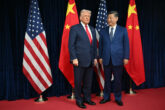February 15, 2022
Biden Can Find Middle Ground in Heated Nuclear Debate
U.S. President Joe Biden is faced with competing pressures as his administration prepares to announce the results of the latest Nuclear Posture Review. The administration; the niche, but important, arms control community in Washington; and foreign allies have been hotly debating whether Washington should adopt a policy pledging that the United States will not be the first to use nuclear weapons in a crisis (a preemptive attack or first strike), referred to as a “no first use” policy, and that the sole purpose of nuclear weapons is to deter a nuclear attack against America and its allies, referred to as a “sole purpose” policy. Both sides fiercely argue their viewpoint—but a middle way is possible.
Declaring a no-first-use policy would inevitably be accompanied by making changes to U.S. force posture and structure, including increasing the time and steps it takes to launch a nuclear weapon.
In January 2017, then-Vice President Biden articulated his long-held belief that the United States does not need to use nuclear weapons first. It mirrored then-President Barack Obama’s convictions about reducing the role of nuclear weapons and America’s “moral responsibility … to seek the peace and security of a world without nuclear weapons.” It also reflected a reduction in Washington’s perceived need to retain the first-use option against non-nuclear attacks since the end of the Cold War. During his 2020 presidential campaign, Biden pledged to push for a no-first-use policy, with his website stating, “As president, he will work to put that belief into practice, in consultation with our allies and military.”
Biden is being pressed to make good on his campaign commitment by Democratic leaders such as Sen. Elizabeth Warren and Rep. Adam Smith, who reintroduced the No First Use Bill in April 2021 and signed on to a letter delivered to the president on Jan. 26, and he is also facing pressure from some experts in the nongovernmental arms control community.
Read the full article from Foreign Policy.
More from CNAS
-
North Korea Reveals Troop Dispatch to Russia amid U.S.-South Korea Policy Talks
North Korea has confirmed for the first time that its troops are operating in Russia, and it is preparing to rewrite its party charter with the possibility of officially namin...
By Dr. Go Myong-Hyun
-
Chinese Maker of Bitcoin-Mining Machines Is a Security Threat, Says Expert
Bloomberg News reports that a Chinese manufacturer, Bitmain Technologies Ltd, that sells most of the world’s Bitcoin-mining machines — including 16,000 of them to a venture ba...
By David Feith
-
Indo-Pacific Security / Energy, Economics & Security
North Korea’s Provocations, Power Plays, and Shifting AlliancesTensions on the Korean Peninsula have reached a new and dangerous threshold. President Lee Jae Myung is warning of a real risk of accidental military clashes, as the situation...
By Dr. Go Myong-Hyun
-
Indo-Pacific Security / Energy, Economics & Security
How to Win the Economic War with ChinaTrump's approach to China has run aground, giving Beijing unprecedented advantage in the economic conflict....
By Edward Fishman & Julian Gewirtz



